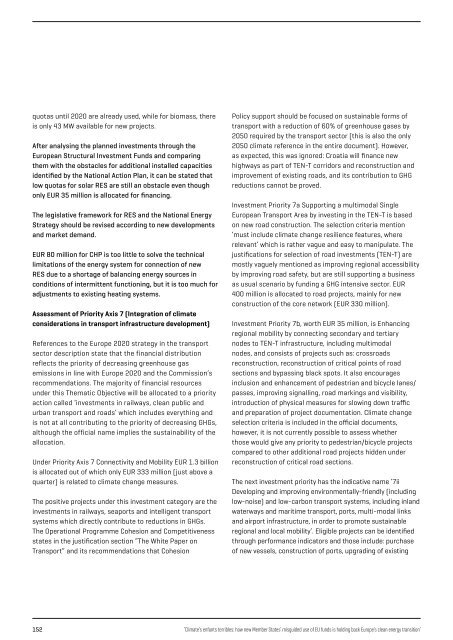ENFANTS TERRIBLES
enfants-terribles
enfants-terribles
You also want an ePaper? Increase the reach of your titles
YUMPU automatically turns print PDFs into web optimized ePapers that Google loves.
quotas until 2020 are already used, while for biomass, there<br />
is only 43 MW available for new projects.<br />
After analysing the planned investments through the<br />
European Structural Investment Funds and comparing<br />
them with the obstacles for additional installed capacities<br />
identified by the National Action Plan, it can be stated that<br />
low quotas for solar RES are still an obstacle even though<br />
only EUR 35 million is allocated for financing.<br />
The legislative framework for RES and the National Energy<br />
Strategy should be revised according to new developments<br />
and market demand.<br />
EUR 80 million for CHP is too little to solve the technical<br />
limitations of the energy system for connection of new<br />
RES due to a shortage of balancing energy sources in<br />
conditions of intermittent functioning, but it is too much for<br />
adjustments to existing heating systems.<br />
Assessment of Priority Axis 7 (Integration of climate<br />
considerations in transport infrastructure development)<br />
References to the Europe 2020 strategy in the transport<br />
sector description state that the financial distribution<br />
reflects the priority of decreasing greenhouse gas<br />
emissions in line with Europe 2020 and the Commission’s<br />
recommendations. The majority of financial resources<br />
under this Thematic Objective will be allocated to a priority<br />
action called ‘investments in railways, clean public and<br />
urban transport and roads’ which includes everything and<br />
is not at all contributing to the priority of decreasing GHGs,<br />
although the official name implies the sustainability of the<br />
allocation.<br />
Under Priority Axis 7 Connectivity and Mobility EUR 1.3 billion<br />
is allocated out of which only EUR 333 million (just above a<br />
quarter) is related to climate change measures.<br />
The positive projects under this investment category are the<br />
investments in railways, seaports and intelligent transport<br />
systems which directly contribute to reductions in GHGs.<br />
The Operational Programme Cohesion and Competitiveness<br />
states in the justification section “The White Paper on<br />
Transport” and its recommendations that Cohesion<br />
Policy support should be focused on sustainable forms of<br />
transport with a reduction of 60% of greenhouse gases by<br />
2050 required by the transport sector (this is also the only<br />
2050 climate reference in the entire document). However,<br />
as expected, this was ignored: Croatia will finance new<br />
highways as part of TEN-T corridors and reconstruction and<br />
improvement of existing roads, and its contribution to GHG<br />
reductions cannot be proved.<br />
Investment Priority 7a Supporting a multimodal Single<br />
European Transport Area by investing in the TEN-T is based<br />
on new road construction. The selection criteria mention<br />
’must include climate change resilience features, where<br />
relevant’ which is rather vague and easy to manipulate. The<br />
justifications for selection of road investments (TEN-T) are<br />
mostly vaguely mentioned as improving regional accessibility<br />
by improving road safety, but are still supporting a business<br />
as usual scenario by funding a GHG intensive sector. EUR<br />
400 million is allocated to road projects, mainly for new<br />
construction of the core network (EUR 330 million).<br />
Investment Priority 7b, worth EUR 35 million, is Enhancing<br />
regional mobility by connecting secondary and tertiary<br />
nodes to TEN-T infrastructure, including multimodal<br />
nodes, and consists of projects such as: crossroads<br />
reconstruction, reconstruction of critical points of road<br />
sections and bypassing black spots. It also encourages<br />
inclusion and enhancement of pedestrian and bicycle lanes/<br />
passes, improving signalling, road markings and visibility,<br />
introduction of physical measures for slowing down traffic<br />
and preparation of project documentation. Climate change<br />
selection criteria is included in the official documents,<br />
however, it is not currently possible to assess whether<br />
those would give any priority to pedestrian/bicycle projects<br />
compared to other additional road projects hidden under<br />
reconstruction of critical road sections.<br />
The next investment priority has the indicative name ‘7ii<br />
Developing and improving environmentally-friendly (including<br />
low-noise) and low-carbon transport systems, including inland<br />
waterways and maritime transport, ports, multi-modal links<br />
and airport infrastructure, in order to promote sustainable<br />
regional and local mobility’. Eligible projects can be identified<br />
through performance indicators and those include: purchase<br />
of new vessels, construction of ports, upgrading of existing<br />
152<br />
‘Climate’s enfants terribles: how new Member States’ misguided use of EU funds is holding back Europe’s clean energy transition’


